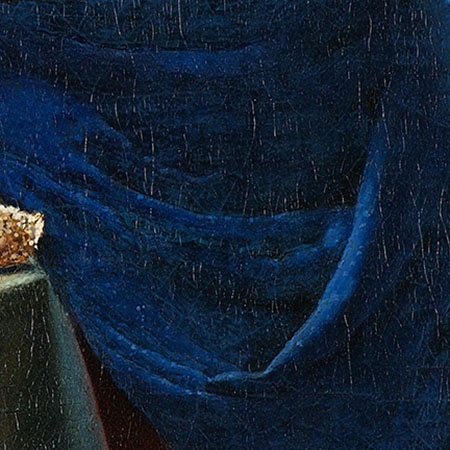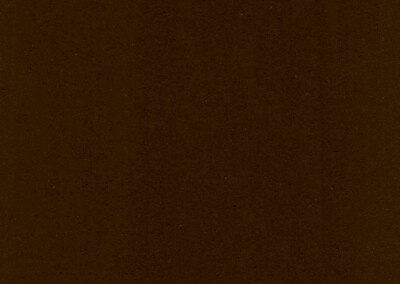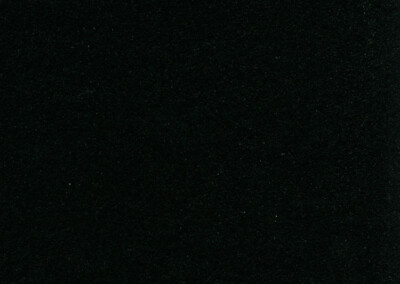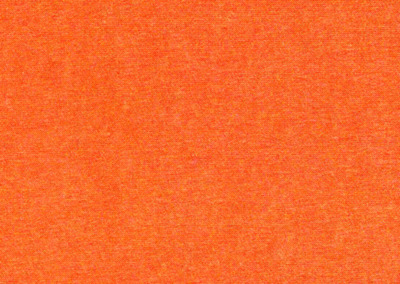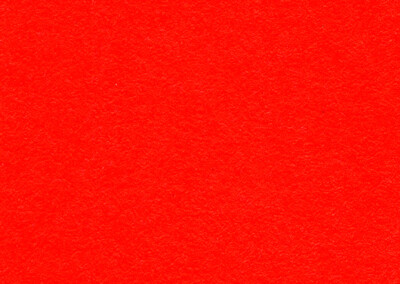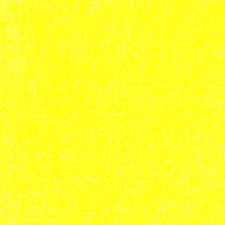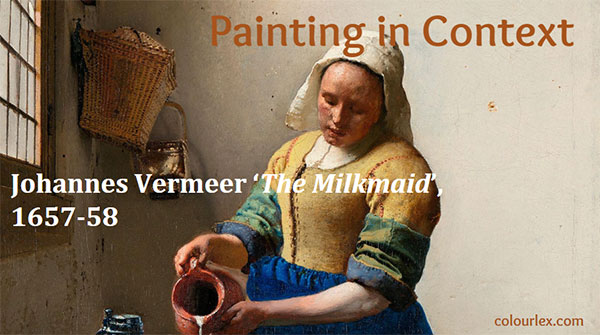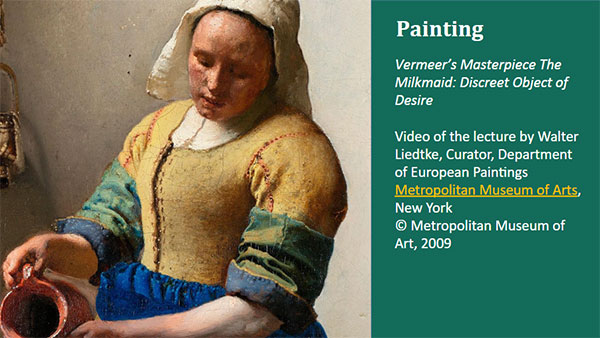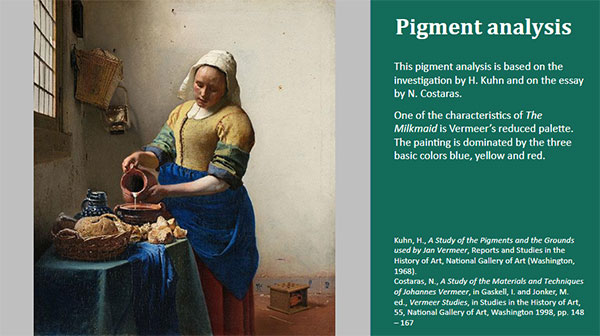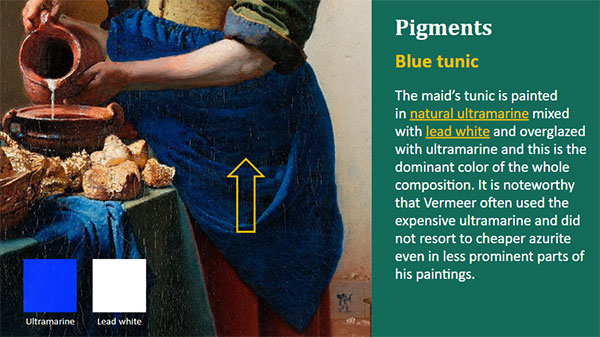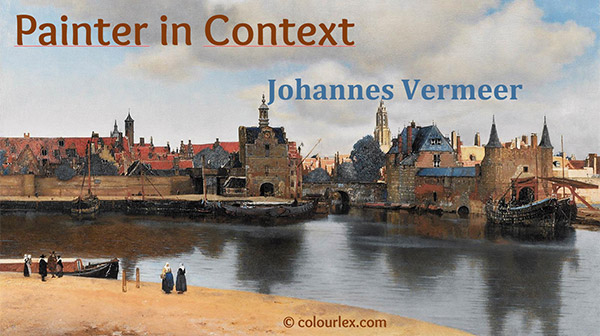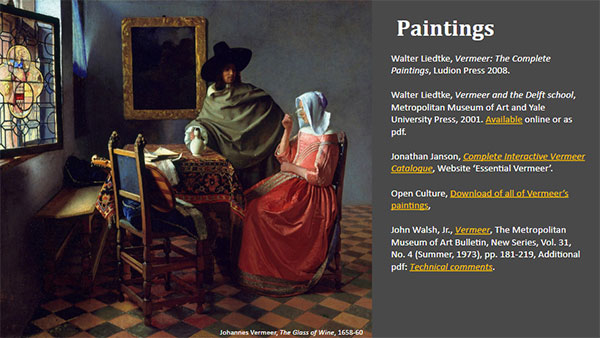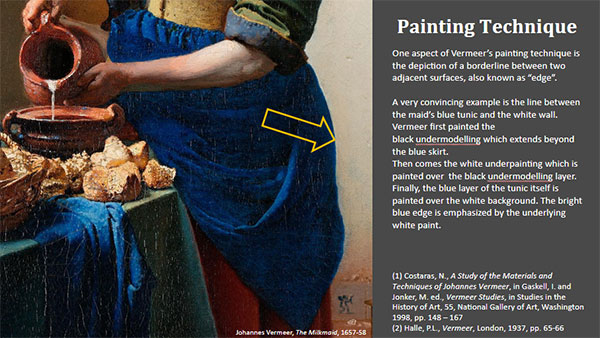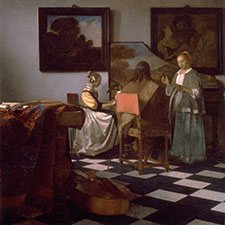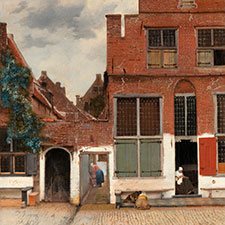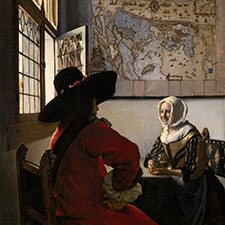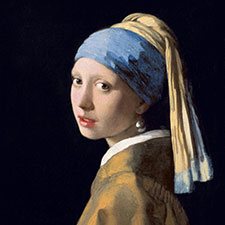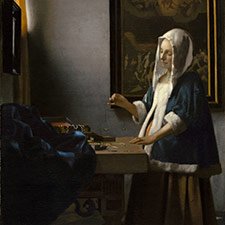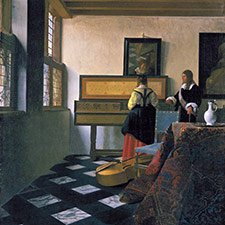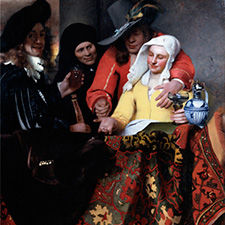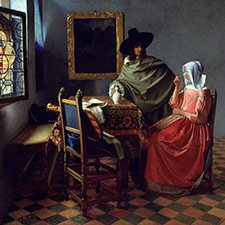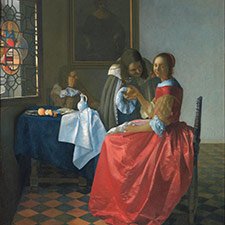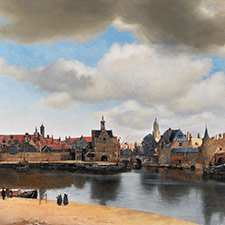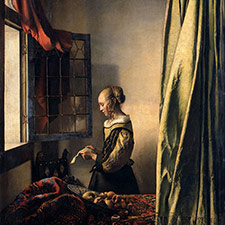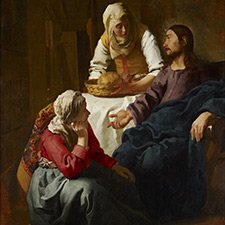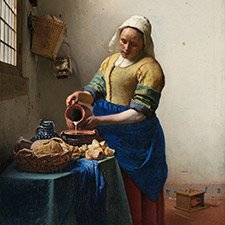Johannes Vermeer, The Milkmaid
1657-58Paintings sorted by Historical period | Painter | Subject matter | Pigments used
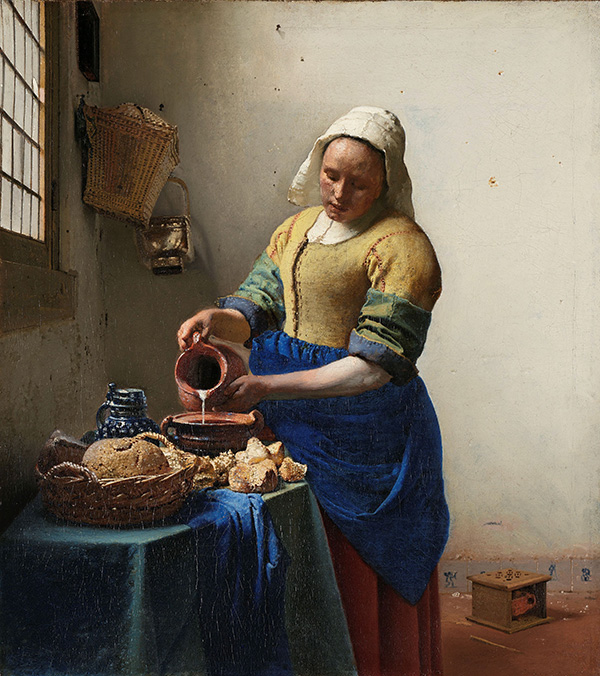
The woman’s blue tunic
Natural ultramarine mixed with lead white and overglazed with ultramarine
Blue cloth on the table
Natural ultramarine mixed with lead white and overglazed with ultramarine
The gray-bluish table cloth
A mixture of natural ultramarine and lead white but with different content of ultramarine compared to the blue skirt
The yellow upper part of the tunic
Is painted in lead-tin-yellow and contrasts nicely with the blue skirt. The lighter parts of the sleeve are painted in lead-tin-yellow mixed with natural ultramarine, while the darker parts contain ultramarine mixed with lead white and are overglazed with ultramarine
The blue-gray overturned sleeve
Vermeer painted first a ground layer of ochre which he then overpainted with a mixture of ultramarine and lead white
Whitewashed wall in the background
Vermeer used a mixture of umber, black, and lead white to render the feeling of texture and realism further underscored by numerous cracks, stains, nails, and holes.
The decoration on the wine jug
It is marbled wet-in-wet with a blue ultramarine glaze
The red skirt
Madder lake and lead white over charcoal black
The brown floor in the lower right
Red ochre, charcoal black, and lead white
The dark shadow over the table on the left
Umber and charcoal black and a little lead white
Hover the mouse over the white points to learn about the pigments used at this spot.
Overview
Medium: Oil
Support: Canvas
Size: 46 cm x 41 cm
Art period: Baroque
Rijksmuseum, Amsterdam
SK-A-2344
The Milkmaid, high-resolution image and a story about the painting at Google Arts and Culture
Overview
Medium: Oil
Support: Canvas
Size: 46 cm x 41 cm
Art period: Baroque
Rijksmuseum, Amsterdam
SK-A-2344
The Milkmaid, high-resolution image and a story about the painting at Google Arts and Culture
Exhibition at the Metropolitan Museum New York
In 1609, a Dutch ship named Halve Maen (Half Moon) sailed into the mouth of a river later named after the captain of the ship, Henry Hudson. The settlers founded the Dutch colony, which became Nieuw Amsterdam, but was later renamed New York after being captured by the English. 400 years later, Vermeer’s The Milkmaid was chosen as the centerpiece of the exhibition in the Metropolitan Museum of Art as part of the celebrations of the 400th anniversary of Hudson’s voyage. The catalog to this exhibition contains an exceedingly comprehensive and detailed analysis of this painting by Walter Liedtke (2). His lecture at the opening of the exhibition can be found on this page under the tab ‘videos’.
Walter Liedtke (1) describes the special character of ‘The Milkmaid’ in the following words:
In The Milkmaid, tactile and optical sensations coexist: nowhere else in Vermeer’s oeuvre does one find such a sculptural figure and such seemingly tangible objects, and yet the future painter of luminous interiors has already arrived. As if conforming to the play between optical and tactile qualities throughout the picture, the pointillist pattern of bright dots on the bread and basket, Vermeer’s most effusive use of the scheme, suggests scintillating daylight and rough textures at the same time.
References
(1) Liedtke, W., “Johannes Vermeer (1632–1675) and The Milkmaid“, In Heilbrunn Timeline of Art History, New York: The Metropolitan Museum of Art, 2000
(2) Liedtke, W., The Milkmaid by Johannes Vermeer. Exhibition catalog, New York: Metropolitan Museum of Art, 2009.
Pigments
Painting Technique and Pigment Analysis
The ground (lower edge) consists of chalk, lead white, and umber. One of the characteristics of The Milkmaid is Vermeer’s reduced palette. The painting is dominated by the three basic colours blue, yellow and red.
The woman’s tunic is painted in natural ultramarine mixed with lead white and overglazed with ultramarine and this is the dominant colour of the whole composition. It is noteworthy that Vermeer used the expensive ultramarine in several of his paintings and did not resort to cheaper azurite even in less prominent parts of his paintings. The blue cloth on the table is painted in the same mixture of these two pigments.
One aspect of Vermeer’s painting technique where he was a real master is the depiction of a borderline between two adjacent surfaces, also known as “edge”. A very convincing example is the line between the maid’s blue tunic and the white wall [(4) quoted in (3)]. Vermeer first painted the black undermodelling which extends beyond the blue skirt. Then comes the white underpainting which is painted over the black undermodelling layer. Finally, the blue layer of the tunic itself is painted over the white background. The bright blue edge is emphasized by the underlying white paint.
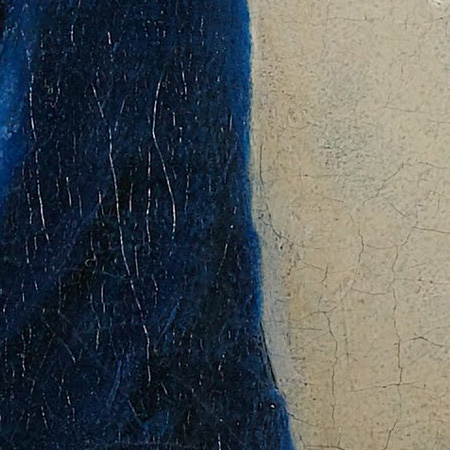
The yellow upper part of the tunic is painted in lead-tin-yellow and contrasts nicely with the blue skirt. The lighter parts of the sleeve are painted in lead-tin-yellow mixed with natural ultramarine, while the darker parts contain ultramarine mixed with lead white and are overglazed with ultramarine. In the blue-gray overturned sleeve Vermeer painted first a ground layer of ochre which he then overpainted by a mixture of ultramarine and lead white.
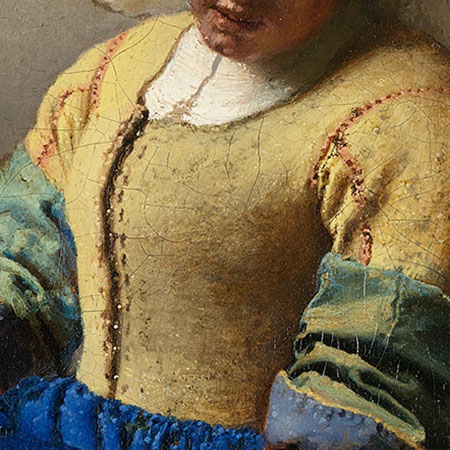
There are other areas showing the mastery of Vermeer’s handling of the painting technique. The most prominent of them is the natural rendering of the whitewashed wall in the background of the painting. Vermeer used a mixture of umber, black, and lead white to render the feeling of texture and realism further underscored by numerous cracks, stains, nails, and holes.
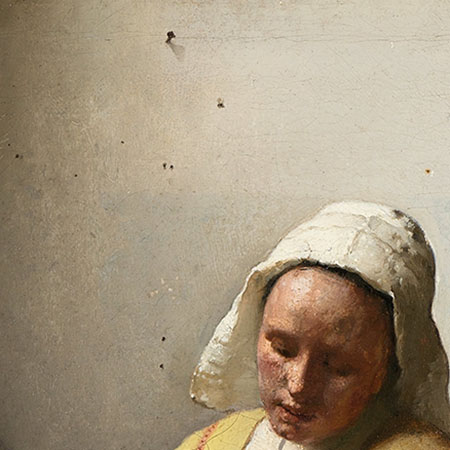
Each raised decoration on the wine jug is marbled wet-in-wet with a blue ultramarine glaze.
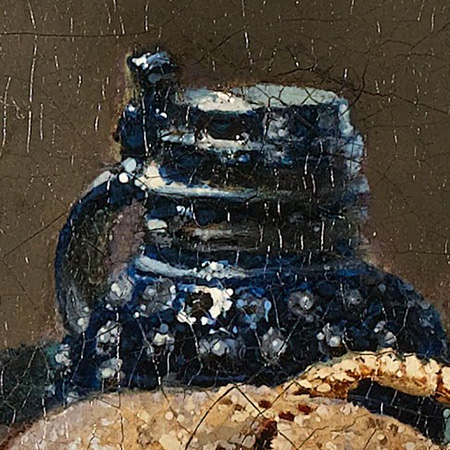
The gray-bluish table cloth is again painted in a mixture of natural ultramarine and lead white but with different content of ultramarine compared to the blue skirt.
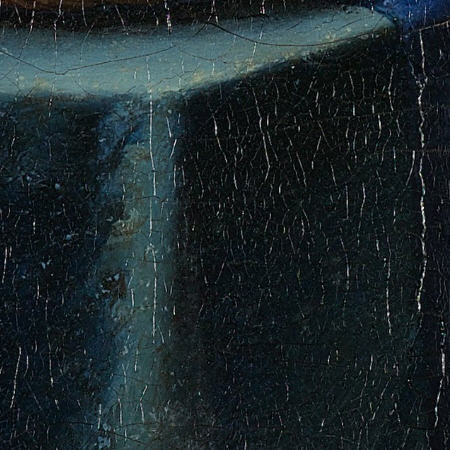
The red skirt is painted in madder lake and lead white over charcoal black.
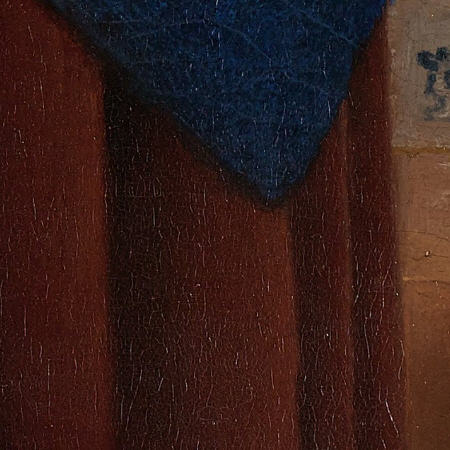
The brown floor in the lower right was painted in red ochre, charcoal black and lead white.
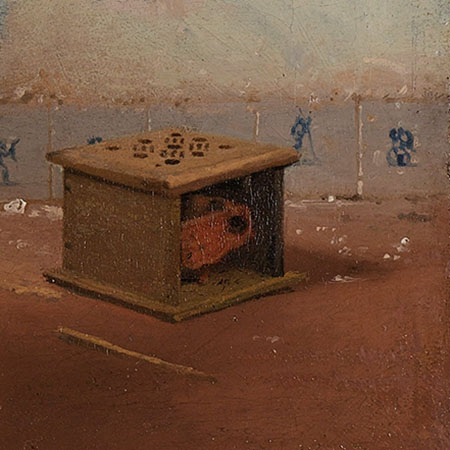
The dark shadow over the table on the left contains umber and charcoal black and a little lead white.
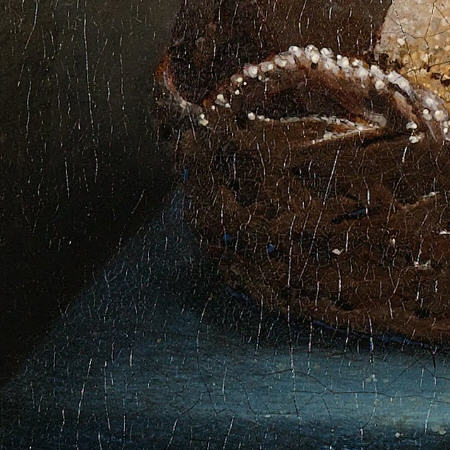
Resources
(1) Kuhn, H., A Study of the Pigments and the Grounds used by Jan Vermeer, Reports and Studies in the History of Art, National Gallery of Art (Washington, 1968).
(2) Janson, J. Vermeer’s Palette, in Essential Vermeer Website.
(3) Costaras, N., A Study of the Materials and Techniques of Johannes Vermeer, in Gaskell, I. and Jonker, M. ed., Vermeer Studies, in Studies in the History of Art, 55, National Gallery of Art, Washington 1998, pp. 148 – 167
(4) Halle, P.L., Vermeer, London, 1937, pp. 65-66
Pigments Used in This Painting
Resources
See the collection of online and offline resources such as books, articles, videos, and websites on Johannes Vermeer in the section ‘Resources on Painters‘
PowerPoint Presentations
Painting in Context: Johannes Vermeer, The Milkmaid
A richly illustrated presentation on the painting technique and pigments employed by Johannes Vermeer in ‘The Milkmaid’ specially crafted for Art Education. (Number of Slides = 16)
- Each presentation starts with the basic information on the painting such as its location in a museum or a gallery, the map of the location of the scene if applicable, and other pertinent details such as the history of the painting and the story depicted by the painter.
- Next, you find slides describing the painting technique of the artist and, if applicable, information on the scientific investigation of the artwork.
- The majority of the slides shows a detailed pigment analysis of the painting containing detailed views of different areas of the artwork and the pigments employed by the painter.
The first slides discuss the general outlook of this Baroque painting and the available resources describing it.
The source and the description of the pigment analysis of The Milkmaid.
The rest of the slides describe the pigments employed by Vermeer in the various areas of the painting.and his involved painting technique.
Painter in Context: Johannes Vermeer
A richly illustrated presentation on the painting technique and pigments employed by Johannes Vermeer specially crafted for Art Education. (Number of Slides = 24)
- Each presentation starts with the basic resources on the painter such as his biography, main catalogs of his paintings, and a bibliography.
- Next, you find slides describing the painting technique of the artist and the pigments he usually employed in his work.
- The majority of the slides show examples of paintings containing the specific pigments.
Slides showing the basic resources on the paintings of the Dutch Baroque painter Johannes Vermeer.
The painting technique of Johannes Vermeer is described and illustrated in the next slides.
The majority of the slides show important examples of paintings where Vermeer employed specific pigments. The slides are organized according to the color of the pigments.
Videos
Video: 'Johannes Vermeer, The Milkmaid' by Walter Liedke, Metropolitan Museum of Art
Vermeer’s Masterpiece The Milkmaid: Discreet Object of Desire
Lecture by Walter Liedtke, Curator, Department of European Paintings, Metropolitan Museum of Art, New York
© Metropolitan Museum of Art, 2009
Video: 'The Objects in the Painting The Milkmaid' by Walter Liedke and Alexandra Gaba van Dongen
From New York with Love
Museum Boijmans Van Beuningen, Rotterdam
Metropolitan Museums curator of European paintings Walter Liedtke invited the curator of Pre-industrial Design Alexandra Gaba-van Dongen of the Museum Boijmans Van Beuningen to identify the depicted artifacts on The Milkmaid. This is the travellog about her journey. Vermeer depicted these objects in much realistic detail. Real examples of these objects were exhibited alongside The Milkmaid at the Metropolitan Museum.
Video: 'Vermeer and Music - The Milkmaid' by Taco Dibbits, Chief Curator of the Rijksmuseum, Amsterdam
Taco Dibbits, Chief Curator of the Rijksmuseum, Amsterdam, discusses the cultural significance and artistic techniques of Vermeer’s “The Milkmaid.
Video: 'The secrets of The Milkmaid by Rijksmuseum, Amsterdam
Scientists have been studying The Milkmaid for centuries, but what mysteries does it still hold? Our researchers have been working with the Mauritshuis in The Hague and the University of Antwerp, studying all the Vermeer paintings in the Netherlands. In this video, you can see just some of the results! Watch the video.
Publications and Websites
Publications
(1) Liedtke, W., The Milkmaid by Johannes Vermeer. Exhibition catalog, New York: Metropolitan Museum of Art, 2009.
(2) Gaskell, I. and Jonker, M., Vermeer Studies, in Studies in the History of Art, 55, National Gallery of Art, Washington 1998.
(3) Marjorie E. Wieseman, Wayne Franits & H. Perry Chapman, Vermeer’s Women: Secrets and Silence, Yale University Press 2011.
(4) Salomon, N. From Sexuality to Civility: Vermeer’s Women, in Gaskell, I. and Jonker, M. ed., Vermeer Studies, in Studies in the History of Art, 55, National Gallery of Art, Washington 1998, pp. 309-322.
(5) Jason Thomas Schuck, Looking at Vermeer’s Milkmaid, Senior Honors Thesis, Stony Brook University, Department of Art, Spring 2013.
Websites
The Milkmaid, high-resolution image and a story about the painting at Google Arts and Culture
Essential Vermeer website

